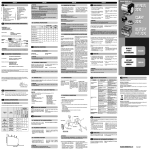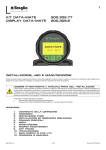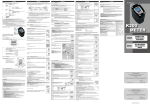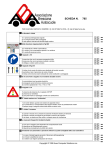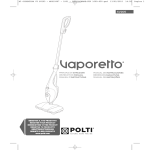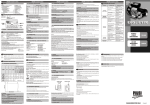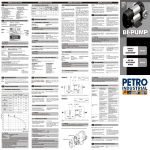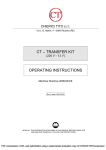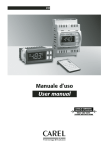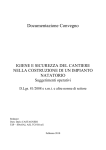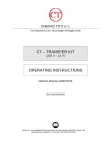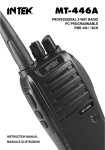Download K24 - Centre Tank Services
Transcript
ENGLISH ENGLISH A6 INDEX A B C D E F G H I L A Battery Housing The k24 is powered by two standard type 1.5 V batteries (size AAA). The battery housing, easily accessible, is closed by a metal cover sealed through a rubber protection acting as a gasket as well. The whole unit can be easily removed by unscrewing the 4 screws fixing the cover and the protection to the body. BECOMING ACQUAINTED WITH K24 A1 Measurement System A2 Display Positioning A3 Operating modes A4 LCD display A5 User Buttons A6 Battery Housing INSTALLATION DAILY USE C1 Dispensing in Normal mode C1.1 Partial reset C1.2 Resetting the Reset Total C.2 Dispensing with Flow Rate Mode display C.2.1 Partial reset CALIBRATION D1 Definitions D2 Why Calibrate D3 Calibration procedure: D3.1 Display Of Current “K Factor” And Restoring “Factory K Factor” D3.2 In-field Calibration D3.2.1 In-field calibration procedure: D3.3 Direct modification of K factor METERS CONFIGURATION MAINTENANCE MALFUNCTIONS TECHNICAL SPECIFICATIONS DISPOSAL EXPLODED VIEWS AND OVERALL DIMENSIONS B INSTALLATION ! ATTENTION At the female inlets, tighten the couplings at a max. torque of 55N/m. To reset the Partial Register, finish dispensing and wait for the Remote Display to show a Flow Rate of 0.0 as indicated in the illustration then quickly press RESET 1 C.2.1 2 Below are the two typical normal operation displays. One display page shows the partial and reset total registers. The other shows the partial and general total. Switchover from resettable total to general total display is automatic and tied to phases and times that are in factory set and cannot be changed. 1 With body made of inconductive plastic material of light colour, designed to be used with water / urea solution 2 With body made of conductive plastic material of dark colour (assessed resistance: 50 ohm), designed to be used with DIESEL FUEL, WATER and windscreen fluids.T he card can be rotated with respect to its housing, thus allowing easy display readings in any position. The card housing, easily accessible, is closed by a plastic cover sealed through a rubber protection acting as a gasket as well. The whole unit can be easily removed by unscrewing the 4 screws fixing the card and the cover. NOTE: 6 digits are available for Totals, plus two icons x 10 / x100. The increment sequence is the following: 0.0 → 99999.9 → 999999 → 100000 x 10 → 999999 x 10 → 100000 x 100 → 999999 x 100 C1 Turbine measurement system. The turbine is placed inside a hole through the body of k24, fitted with threaded inlet and outlet. The body of k24 is made of a plastic material that allows several types of threads with relevant combinations. K24 has 2 rubber protections, designed to act as gaskets, too, and thus reducing the number of its components. The liquids compatible with k24 must be at low viscosity, namely: - Diesel fuel - Water - Water/urea solution - Kerosene - Windscreen - Petrol Main components: Dispensing in Normal mode Normal mode is the standard dispensing. While the count is made, the partial and resettable total are displayed at the same time (reset total). Should one of the keys be accidentally pressed during dispensing, this will have no effect. A few seconds after dispensing has ended, on the lower register, the display switches from resettable total to general total: the word reset above the word total disappears, and the reset total is replaced by the general total. This situation is called standby and remains stable until the user operates the k24 again. LCD Display C1.1 Reset Button Partial reset The partial register can be reset by pressing the reset key when the meter is in standby, meaning when the display screen shows the word “TOTAL”. Cal Button After pressing the reset key, during reset, the display screen first of all shows all the lit-up digits and then all the digits that are not lit up. At the end of the process, a display page is first of all shown with the reset partial and the reset total Display Positioning The square shape of the k24 body allows the card to be rotated in its housing, thus ensuring great versatility in positioning. 4 DISPENSING INTO SAMPLE CONTAINER Without pressing any KEY, start dispensing into the sample container. CALIBRATION D1 Definitions Calibration factor or “k factor” : Multiplication factor applied by the system to the electrical pulses received, to transform these into measured fluid units. FACTORY K FACTOR: Factory-set default factor. It is equal to 1,000. This calibration factor ensures utmost precision in the following operating conditions: Fluid diesel fuel Temperature: 20°c Flow rate: 10-120 litres/min Even after any changes have been made by the user, the factory k factor can be restored by means of a simple procedure. C1.2 ! ATTENTION While fixing the K24 card, make sure the battery contact cable is not placed above the circular housing of the bulb. Resetting the Reset Total The reset total resetting operation can only be performed after resetting the partial register. The reset total can in fact be reset by pressing the reset key at length while the display screen shows reset total as on the following display page: H Combination no. Unit of Measurement of the Partial Register 1 2 3 4 Litres (L) Gallons (Gal) Quarts (Qts) Pints (Pts) Register Unit of Measurement of the Totals Register Litres Gallons Gallons Gallons (L) (Gal) (Gal) (Gal) To choose between the 4 available combinations: • wait for K24 to go to Standby, • press the CAL and RESET keys together. Keep these pressed until the word “UNIT” appears on the screen together with the unit of measurement set at that time (in this example Litres / Litres) • Press the reset key to select the desired combination of unit of measurement, amongst those shown below. • Save the new combination by pressing the cal key at length. K24 will pass through the start cycle and will then be ready to dispense in the set units. Indicated value 5 6 USER K FACTOR: Customized calibration factor, meaning modified by calibration. Real value SHORT RESET KEY KEYING K24 is informed that the calibration dispensing operation is finished. Make sure dispensing is correctly finished before performing this operation. To calibrate the K24, the value indicated by the partial totaliser (example 9.800) must be forced to the real value marked on the graduated sample container. In the bottom left part of the display an arrow appears (upwards and downwards), THAT SHOWS the direction (increase or decrease) of the USER K FACTOR value change when the operations 6 or 7 are performed SHORT RESET KEY KEYING Arrow direction changes. The operation can be repeated IF NECESSARY ! F Measurement system TURBINE Resolution (nominal) Hi Flow 0.010 lit/pulse Low Flow 0.005 lit/pulse Flow Rate (Range) K24 COL. BLACK Flowrates: 5 ÷ 120 (Litres/minute) FOR DIESEL FUEL, WATER,. K24 COL. BEIGE Flowrates 5 ÷ 100 (Litres/minute) FOR WATER/ UREA SOLUTION.. Operating pressure (Max) Bursting pressure (Min) MAINTENANCE K24 has been designed to require a minimum amount of maintenance. The only types of maintenance required are the following: 1. Battery change – necessary when the batteries have run down 2. Cleaning of the turbine with washing or mechanically-handling 40 (Bar) -20 ÷ + 70 (°C) Storage humidity 95 (% RU) (Max) ELECTRONIC TURBINE METER 10 (Bar) 145 (psi) Storage temperature (Range) Operating temperature (Range) -10 ÷ + 50 (°C) Flow resistance 0.30 Bar at 100 lit/min. Viscosity (Range) 2 ÷ 5.35 cSt Accuracy ±1% after calibration within 10÷90 (litres/min) 2,65÷23,8 (gallons/ min) range Reproducibility WARNING The Resettable Total and Total registers will be automatically changed to the new unit of measurement. NO new calibration is required after changing the Unit of Measurement. K24 TECHNICAL SPECIFICATIONS (Typical) Screen ±0,3 (%) Liquid crystals LCD. Featuring: - 5-figure partial - 6-figure Reset Total plus x10 / x100 6-figure non reset Total plus x10 / x100 Power Supply 2x1.5 V alkaline batteries size AAA Battery life 18 ÷ 36 months Weight 0.25 Kg (included batteries) Protection IP65 Calibration procedure: 7 8 K24 permits making quick and precise electronic calibration by changing the calibration factor (k factor). There are 2 different ways of calibration: 1. On-site calibration, performed by means of a dispensing operation. 2. Direct calibration, performed by directly changing the k factor. To enter the calibration phases it is necessary to press and hold down the “cal” button. Why enter the calibration phases? • Display the currently used calibration factor • Return to factory k factor after a previous calibration with user k factor • Change the calibration factor using one of the two previously indicated procedures. In calibration mode, the partial and total dispensed quantities indicated on the display screen take on different meanings according to the calibration procedure phase. During the calibration, the k24 cannot perform any normal dispensing operations. In calibration mode, the totals are not increased. ! WARNING The k24 features a non-volatile memory. It keeps the calibration and dispensing data stored even after replacing new batteries or long periods of inactivity. 9 10 SHORT/LONG CAL KEY KEYING The indicated value changes in the direction indicated by the arrow - one unit for every short CAL key keying - continually if the CAL key is kept pressed. (for the first 5 units slowly and then quickly). If the desired value is exceeded, repeat the operations from point (6). LONG RESET KEY KEYING K24 is informed that the calibration procedure is finished. Before doing this, make sure the DISPLAYED factor is the ACTUAL factor. 1 Battery Replacement K24 is complete with 2 x 1.5 V. alkaline batteries SIZE AAA. K24 features two low-battery alarm levels: Indicated value Real value K24 calculates the new USER K FACTOR. This calculation could require a few seconds, depending on the correction to be made. During this operation the arrow disappears but the CAL indication remains. If this operation is performed after operation (5), without changing the indicated value, the USER K FACTOR would be the same as the FACTORY K FACTOR, thus it is ignored. NO OPERATION At the end of the calculation, the new USER K FACTOR is shown for a few seconds, after which the restart cycle is repeated to finally achieve standby condition. ATTENTION: From now on, the indicated factor will become the calibration factor used by the meter and will continue to remain such even after a battery change NO OPERATION K24 stores the new calibration factor and is ready for dispensing, applying the newly defined USER K FACTOR. D3.3 Display Of Current “K Factor” And Restoring “Factory K Factor” By pressing the cal key while the appliance is in standby, the display page appears showing the current calibration factor used. If you are using k24 with “factory k factor”, the display page shown in the diagram will be displayed, with the word “fact”. If one “user k factor” has been set, the calibration factor set by the user (in our example 0.998) will be displayed. The word “user” indicates a calibration factor set by the user is being used. Direct modification of K factor Example: Error percentage found E% CURRENT calibration factor New USER K FACTOR ( 100 - E% 100 ) - 0.9 % 1,000 1,000 * [(100 – ( - 0,9))/100]= 1,000 * [(100 + 0,9)/100] = 1.009 If the meter indicates less than the real dispensed value (negative error) the new calibration factor must be higher than the old one as shown in the example. The opposite applies if the meter shows more than the real dispensed value (positive error). DISPOSAL 1) When the battery charge falls below the first level on the LCD, the fixed battery symbol appears. The components must be given to companies that specialise in the disposal and recycling of industrial waste and, in particular, the In this condition, K24 continues to operate correctly, but the fixed icon warns the user that it is ADVISABLE to change the batteries. DISPOSAL OF PACKAGING. The packaging consists of biodegradable cardboard which can be delivered to companies for normal recycling of cellulose. 2) If K24 operation continues without changing the batteries, the second battery alarm level will be reached which will prevent operation. In this condition the battery icon starts to flash and is the only one to remain visible on the LCD. DISPOSAL OF METAL COMPONENTS The metal components, both painted and stainless steel, are usually recycled by companies that are specialised in the metal-scrapping industry. ! DISPOSAL OF ELECTRIC AND ELECTRONIC COMPONENTS: these have to be disposed by companies that are specialised in the disposal of electronic components, in accordance with the instructions of 2002/96/EC (see text of Directive below). To change the batteries, with reference to the exploded diagram positions, proceed as follows: • Press RESET to update all the totals • Loosen the 4 fixing screws of the lower cover • Remove the old batteries • Place the new batteries in the same position as the old ones • close the cover again, by positioning the rubber protection as a gasket • K24 will switch on automatically and normal operation can be resumed. ENVIRONMENTAL INFORMATION FOR CUSTOMERS IN THE EUROPEAN UNION European Directive 2002/96/EC requires that the equipement bearing this symbol on the product and/or its packaging must not be disposed of with unsorted municipal waste. The symbol indicates that this product should be disposed of separately from regular household waste streams. It is your responsibility to dispose of this and other electric and electronic equipment via designated collection facilities appointed by the government or local authorities. WARNING Do not discard the old batteries in the environment. Refer to local disposal regulations. This procedure is especially useful to correct a “mean error” obtainable on the basis of several performed dispensing operations. If normal K24 operation shows a mean percentage error, this can be corrected by applying to the currently used calibration factor a correction of the same percentage. In this case, the percentage correction of the USER K FACTOR must be calculated by the operator in the following way: New K Factor = Old K Factor * I The K24 will display the same Reset Total, the same Total and the same Partial indicated before the batteries were changed. After changing the batteries, the meter does not need calibrating again. DISPOSAL OF OTHER PARTS: The disposal of other parts such as pipes, rubber seals, plastic components and cables should be entrusted to companies that special in the disposal of industrial waste. 2. Cleaning Only one operation is necessary to clean the k24. AAfter removing k24 from the plant where it was built in, any residual elements can be removed by washing or mechanically-handling. If this operation does not restore a smooth rotation of the turbine, it will have to be replaced. ! WARNING: Do not use compressed air onto the turbine in order to avoid its damage because of an excessive rotation Schematically, the steps to be taken are: A3 Operating modes The user can choose between two different operating modes: - Normal Mode: Mode with display of Partial and Total dispensed quantities. - Flow Rate Mode: Mode with display of Flow Rate, as well as Partial dispensed quantity. The meter features a non-volatile memory for storing the dispensing data, even in the event of a complete power break for long periods. The measurement electronics and the LCD display are fitted in the top part of the K24 which remains isolated from the fluid-bath measurement chamber and sealed from the outside by means of a cover. A4 LCD display The “LCD” of the METER features two numerical registers and various indications displayed to the user only when the applicable function so requires. 1 9 2 8 Key: 7 1. Partial register (5 3 figures with moving comma FROM 0.1 to 99999) indicating 4 5 6 the volume dispensed since the reset button was last pressed; 2. Indication of battery charge; 3. Indication of calibration mode; 4. Totals register (6 figures with moving comma FROM 0.1 to 999999), that can indicate two types of Total: 4.1. General Total that cannot be reset (TOTAL) 4.2. Resettable total (Reset TOTAL) 5. Indication of total multiplication factor (x10 / x100 ) 6. Indication of type of total, (TOTAL / Reset TOTAL); 7. Indication of unit of measurement of Totals: L=Litres Gal=Gallons 8. Indication of Flow Rate mode 9. Indication of unit of measurement of Partial: Qts=Quarts Pts=Pints L=Litres Gal=Gallons A5 User Buttons The k24 features two buttons (reset and cal) which individually perform two main functions and, together, other secondary functions. The main functions performed are: For the reset key, resetting the partial register and resettable total (reset total) For the cal key, entering instrument calibration mode. Used together, the two keys permit entering configuration mode, useful for changing the units of measurements and calibration factor. 1. Wait for the display to show normal standby display page (with total only displayed), 2. Press the reset key quickly 3. The meter starts to reset the partial 4. While the display page showing the reset total is displayed Press the reset key again for at least 1 second 5. The display screen again shows all the segments of the display followed by all the switched-off segments and finally shows the display page where the reset Reset Total is shown. C.2 Dispensing with Flow Rate Mode display It is possible to dispense fluids, displaying at the same time: * the dispensed partial * the Flow Rate in [Partial Unit / minute] as shown on the following display page: The flow chart alongside shows the switchover logic from one display page to another. In this condition, the Reset key permits switching from User factor to Factory factor. To confirm the choice of calibration factor, quickly press CAL while “User” or “Fact” are displayed. After the restart cycle, the meter uses the calibration factor that has just been confirmed. ! ATTENTION When the Factory Factor is confirmed, the old User factor is deleted from the memory D3.2 Procedure for entering this mode: - wait for the Remote Display to go to Standby, meaning the display screen shows Total only - quickly press the CAL key. - Start dispensing The flow rate is updated every 0.7 seconds. Consequently, the display could be relatively unstable at lower flow rates. The higher the flow rate, the more stable the displayed value. ! IMPORTANT The flow rate is measured with reference to the unit of measurement of the Partial. For this reason, in case of the unit of measurement of the Partial and Total being different, as in the example shown below, it should be remembered that the indicated flow rate relates to the unit of measurement OPERATION 1 NONE K24 in STAND BY: not in counting mode. ! WARNING For correct K24 calibration, it is most important to: • completely eliminate air from the system before calibrating; • use a precise Sample Container with a capacity of not less than 5 litres, featuring an accurate graduated indicator. • ensure calibration dispensing is done at a constant flow rate equivalent to that of normal use, until the container is full; •not reduce the flow rate to reach the graduated area of the container during the final dispensing stage (the correct method during the final stages of sample container filling consists in making short top-ups at normal operation flow rate) ; • after dispensing, wait a few minutes to make sure any air bubbles are eliminated from the sample container; only read the Real value at the end of this stage, during which the level in the container could drop. • if necessary, carefully follow the procedure indicated below. G. DECLARATION OF CONFORMITY MALFUNCTIONS Problem Possible Cause LCD: no indication Bad battery contact 2 3 4 5 LONG CAL KEY KEYING K24 enters calibration mode, shows “CAL” and displays the calibration factor being used instead of the partial. The words “Fact” and “USER” indicate which of the two factors (factory or user) is currently being used. LONG RESET KEY KEYING K24 shows “CAL” and the partial at zero. K24 is ready to perform on-site calibration by dispensing. LONG RESET KEY KEYING We now go on to Direct change of the calibration factor: the word “Direct” appears together with the Currently Used calibration factor. In the bottom left part of the display, an arrow appears (upwards or downwards) defining the direction (increase or decrease) of change of the displayed value when subsequent operations 5 or 6 are performed. SHORT RESET KEY KEYING Arrow direction changes. The operation can be repeated to alternate the direction of the arrow. In-field Calibration This procedure calls for the fluid to be dispensed into a graduated sample container in real operating conditions (flow rate, viscosity, etc.) requiring maximum precision. DISPLAY 6 SHORT/LONG CAL KEY KEYING The indicated value changes in the direction indicated by the arrow one unit for every short CAL key keying continually if the CAL key is kept pressed. The speed increase rises by keeping the key pressed. If the desired value is exceeded, repeat the operations from point (5). 7 LONG RESET KEY KEYING K24 is informed that the calibration procedure is finished. Before performing this operation, make sure the indicated value is that required. 8 NO OPERATION At the end of the calculation, the new USER K FACTOR is shown for a few seconds, after which the restart cycle is repeated to finally achieve standby condition. ATTENTION: From now on, the indicated factor will become the calibration factor used by the meter and will continue to remain such even after a battery change. NO OPERATION The K24 stores the new work calibration factor and is ready to begin dispensing, using the USER K FACTOR that has just been calculated. 9 Not enough measurement precision Reduced or zero flow rate The meter does not count, but the flow rate is correct Azione Correttiva Check battery contacts With reference to paragraph H, check the K FACTOR Wrong K FACTOR The meter works below Increase the flow rate until minimum acceptable flow an acceptable flow rate rate. range has been achieved TURBINE blocked Clean the TURBINE Incorrect installation of gears after cleaning Repeat the procedure Possible electronic problems card reassembly The undersigned, representing the following manufacturer Piusi S.p.A. 46029 – Suzzara (Mantova) - Italy CERTIFIES that the equipment described below: K24 complies with the following directives: 2004/108/CE (Electromagnetic Compatibility Directive) and following amendments Contact your dealer Suzzara 01.07.2009 MANUALE D’USO, MANUTENZIONE E CALIBRAZUIONE Italiano USE, MAINTENANCE AND CALIBRATION MANUAL English Bulletin Why Calibrate When operating close to extreme conditions, such as for instance with fluids close to acceptable range extremes (like diesel fuel at low temperatures) or in extreme flow rate conditions (close to minimum or maximum acceptable values), an on-site calibration may be required to suit the real conditions in which the k24 is required to operate. D3 METERS CONFIGURATION Some models of meter feature a menu with which the user can select the main measurement unit, Quarts (Qts), Pints (Pts), Litres (Lit), Gallons (Gal); The combination of the unit of measurement of the Partial register and that of the Totals is predefined according to the following table: LONG CAL KEY KEYING K24 enters calibration mode, shows ”CAL” and displays the calibration factor in use instead of total. The words “Fact” and “USER” indicate which of the two factors is currently in use. 3 LONG RESET KEY KEYING K24 shows “CAL” and the partial at zero. K24 is ready to perform on-site calibration. Partial reset D D3.1 and, after a few moments, the reset total is replaced by the non resettableTotal. NONE K24 IN STAND BY Dispensing can be interrupted and started again at will. Continue dispensing until the level of the fluid in the sample container has reached the graduated area. There is no need to reach a preset quantity. D2 Measurement System E DISPLAY 3 DAILY USE The only operations that need to be done for daily use are partial and/or resettable total register resetting. The user should use only the dispensing system of k24. Occasionally the meter may need to be configured or calibrated. To do so, please refer to the relevant chapters. In-field calibration procedure: To return to “Normal” mode, press the CAL key again. If one of the two keys RESET or CAL is accidentally pressed during the count, this will have no effect. IMPORTANT Even though in this mode they are not displayed, both the Reset Total and the General Total (Total) increase. Their value can be checked after dispensing has terminated, returning to “Normal” mode, by quickly pressing CAL. C Electronic digital meter featuring a turbine measurement system, designed for precise measuring of low viscosity fluids. It is divided into two using macrogroups: A2 D3.2.1 ENGLISH ENGLISH AZIONE ATTENTION: ITH THE GAS-FEMALE INLETS, DO NOT USE CONICAL THREADED COUPLINGS. BECOMING ACQUAINTED WITH K24 A1 of the partial. In the example shown, the flow rate is expressed in Qts/min. The word “Gal” remaining alongside the flow rate refers to the register of the Totals (Reset or NON Reset) which are again displayed when exiting from the flow rate reading mode. K24 features a threaded, perpendicular inlet and outlet (1” gas or ntp male and female that can be combined together). It has been designed to be easily installed in any position: fixed in-line or mobile on a dispensing nozzle. In order to improve the life of the turbine, it is recommended to fit a strainer before the meter itself ! ! ENGLISH ENGLISH President M0171AITEN rev. 3 INDICE A CONOSCERE K24 A1 Sistema Di Misura A2 Orientamento Display A3 Modalità di utilizzo A4 Display LCD A5 Pulsanti Utente A6 Sede Batterie INSTALLAZIONE USO GIORNALIERO C1 erogazione in modalità normale (normal mode) C1.1 Azzeramento del Parziale C1.2 Azzeramento del Reset Total (Totale Azzerabile) C.2 Erogazione con visualizzazione Portata Istantanea (Flow Rate Mode) C.2.1 Azzeramento del Parziale CALIBRAZIONE D1 DEFINIZIONI D2 PERCHÉ CALIBRARE D3 Modalità di Calibrazione D3.1 visualizzazione “K factor” attuale e ripristino del “factory k factor”. D3.2 Calibrazione In Campo D3.2.1 Procedura per effettuare la Calibrazione in Campo: D3.3 Modifica diretta del K factor CONFIGURAZIONE DEI CONTALITRI MANUTENZIONE MALFUNZIONAMENTI DATI TECNICI SMALTIMENTO VISTE ESPLOSE ED INGOMBRI B C D E F G H I L A CONOSCERE K24 Contalitri elettronico digitale provvisto di un sistema di misura a turbina, progettato per una precisa misurazione di fluidi a bassa viscosita’. Si divide in 2 macro famiglie di utilizzo: 1 - Con corpo realizzato in materiale plastico non conduttivo di colore chiaro, ideato per l’utilizzo con soluzione di acqua/urea 2 - Con corpo realizzato in materiale plastico conduttivo di colore scuro (resistenza accertata: 50 ohm) e ideato per l’utilizzo con GASOLIO, ACQUA e windscreen. La scheda puo’ essere ruotata rispetto alla sua sede. Questo consente una facile lettura del display in tutte le posizioni. La sede della scheda, facilmente accessibile, è chiusa da un coperchio in plastica con tenuta garantita dalla protezione in gomma che funge anche da guarnizione. Il tutto e’ facilmente rimuovibile svitando le 4 viti che fissano coperchio e scheda. A1 Sistema Di Misura Sistema di misura a turbina. La turbina è posizionata all’interno di un foro che attraversa il corpo del k24 e dotato di ingresso ed uscita filettati. I materiale plastico di cui è costrituito il corpo di k24, permette varie filettature e relative numerose combinazioni. K24 e’ corredato da 2 protezioni in gomma, progettate in modo da fungere anche da guarnizioni, riducendo cosi’ il numero di particolari che lo compongono. I liquidi compatibili con il k24 devono essere a bassa viscosità e precisamente i seguenti: - Gasolio - Acqua - Soluzone acqua/urea - Kerosene - Windscreen - Benzina Componenti Principali: Display LCD Tasto Reset A6 Sede Batterie K24 è alimentato da due batterie di tipo standard da 1,5 v (size AAA). La sede delle batterie, facilmente accessibile, è chiusa da un coperchio metallico con tenuta garantita dalla protezione in gomma che funge anche da guarnizione. Il tutto e’ facilmente rimuovibile svitando le 4 viti che fissano coperchio e protezione al corpo. B INSTALLAZIONE K24 ha ingresso e uscita filettati (1” gas o npt maschio e femmina, combinabili tra loro) ed in asse. E’ studiato per essere facilmente installato in qualsiasi posizione: fisso su una linea o mobile su una pistola di erogazione. Prevedere sempre la presenza di un disco filtrante a monte dell’impianto, al fine di garantire maggiore durata della turbina. ! ! ATTENZIONE: Sugli ingressi femmina, serrare i raccordi di giunzione ad una coppia massima di 55N/m ATTENZIONE: SUGLI INGRESSI FEMMINA GAS, NON UTILIZZARE RACCORDI CON FILETTI CONICI C Nota: i digit disponibili per i totali sono 6 a cui si aggiungono due icone x 10 / x100.La sequenza di incremento è la seguente: 0.0 → 99999.9 → 999999 → 100000 X 10 → 999999 x 10 → 100000 x 100 → 999999 x 100 C1 erogazione in modalità normale (normal mode) Normal mode è l’erogazione standard. Durante il conteggio, vengono visualizzati contemporaneamente il “parziale erogato” ed il “totale azzerabile” (reset total). Premere accidentalmente i tasti durante l’erogazione, non comporta alcun effetto Ad alcuni secondi dal termine dell’erogazione, sul registro inferiore la visualizzazione passa dal “totale azzerabile” al ”totale generale”: la scritta reset posta sopra alla scritta total scompare, ed il valore del “totale azzerabile”, viene sostituito dal “totale generale”. Questa situazione viene definita di riposo (o STANDBY) e rimane stabile fino a quando l’utente non effettua altre operazioni sul K24 Azzeramento del Parziale Il Registro del Parziale può essere azzerato premendo il tasto RESET quando il meter è in Stand-by, ovvero quando il display visualizza la scritta «TOTAL». Dopo la pressione del tasto RESET, durante la fase di azzeramento, il display mostra in successione prima tutti i digit accesi, poi tutti i digit spenti. A2 ! ATTENZIONE: In fase di fissaggio scheda del K24, è importante fare attenzione che il cavo del contatto pile non si posizioni sopra la sede circolare dell’ampolla. Modalità di utilizzo L’utente può scegliere tra due modalità diverse di utilizzo: - Normal mode: modalità con visualizzazione delle quantità parziali e totali erogate - Flow rate mode: modalità con visualizzazione della portata istantanea (flow rate), oltre che del parziale erogato Il meter è provvisto di una memoria non volatile che permette di mantenere i dati archiviati delle erogazioni eseguite anche in caso di completa assenza di alimentazione per lunghi periodi. L’elettronica di misura e il display a cristalli liquidi «lcd» sono installati nella parte superiore del k24. Che resta cosi’ isolata dalla camera di misura bagnata dal fluido e sigillata dall’esterno tramite un coperchio. Display LCD L’ «LCD» del meter è provvisto di due registri numerici e di diverse indicazioni che vengono visualizzate dall’utente solamente se la funzione del momento lo richiede Legenda: 1. Registro del parziale (5 cifre a virgola mobile da 0.1 A 99999), che indica il volume erogato dall’ultima volta che è stato premuto il pulsante di reset; 2. Indicazione dello stato di carica delle batterie; 3. Indicazione della 1 9 modalità di calibrazione; 4. Registro dei totali (6 cifre a virgola mobile da 0,1 a 2 8 999999), 7 che può indicare 3 due tipi di totale: 4.1. To t a l e 4 5 6 generale non azzerabile (total) 4.2. Totale azzerabile (reset total) 5. Indicazione del fattore di moltiplicazione dei totali (x10 / x100) 6. Indicazione del tipo di totale, (total / reset total); 7. Indicazione dell’unità di misura dei totali: l=litri gal=galloni 8. Indicazione della modalità “Portata Istantanea” (Flow Rate) 9. Indicazione dell’unità di misura del parziale: qts=quarti; pts=pinte; l=litri; gal=galloni A5 Per tornare nella modalità “Normale” premere nuovamente il tasto CAL. La pressione accidentale di uno dei due tasti RESET o CAL durante il conteggio non ha alcun effetto. ! ATTENZIONE: Anche se in questa modalità non vengono visualizzati, sia il totale azzerabile (Reset Total) che il Totale Generale (Total) si incrementano. E’ possibile controllare il loro valore dopo la fine dell’erogazione, tornando nella modalità “Normale”, premendo brevemente il tasto CAL. C.2.1 Pulsanti Utente K24 è dotato di due pulsanti (reset e cal) che svolgono, singolarmente, due funzioni principali e, in combinazione, altre funzioni secondarie. Le funzioni principali svolte sono: - Per il tasto reset, l’azzeramento del registro del parziale e di quello del totale azzerabile (reset total) - Per il tasto cal, l’entrata nella modalità di calibrazione dello strumento Utilizzati in combinazione, i due tasti consentono di entrare in modalità di configurazione (configuration mode), utile per modifiche sull’unita’di misura e sul fattore di calibrazione. AZIONE 1 2 3 Azzeramento del Parziale Per azzerare il Registro del Parziale occorre terminare l’erogazione, attendere che il Display Remoto indichi un Flow Rate di 0.0 come indicato in figura e poi premere brevemente il tasto RESET. Alla fine del processo viene mostrata dapprima una schermata che presenta il Parziale azzerato e il Reset Total C1.2 Azzeramento del Reset Total (Totale Azzerabile) L’operazione di azzeramento del Reset Total è effettuabile solo successivamente ad una operazione di azzeramento del registro del Parziale. Infatti il Reset Total può essere azzerato premendo a lungo il tasto RESET mentre il display visualizza la scritta RESET TOTAL come nella schermata seguente: Schematicamente i passi da seguire sono: 1. Attendere che il display sia nella schermata normale di stand-by (con il solo Total visualizzato), 2. Premere brevemente il tasto RESET 3. Il meter inizia le sue fasi di azzeramento del Parziale. 4. Mentre è visualizzata la schermata che indica il Reset Total premere nuovamente il tasto Reset per un tempo di almeno 1 secondo 5. Il display torna nuovamente a mostrare tutti i segmenti del display seguito dalla fase con tutti e segmenti spenti per giungere alla schermata in cui viene visualizzato il Reset Total azzerato. C.2 Erogazione con visualizzazione Portata Istantanea (Flow Rate Mode) E’ possibile effettuare erogazioni visualizzando contemporaneamente: • il parziale erogato • la Portata Istantanea (Flow Rate) in [Unità del Parziale /minuto] come indicato nella schermata seguente: Procedura per entrare in questa modalità: • attendere che il Display Remoto sia in Stand-By, ovvero che il display visualizzi il solo Total • premere brevemente il tasto CAL. • Iniziare l’erogazione La portata istantanea viene aggiornata ogni 0,7 secondi. Pertanto alle portate più basse si potrà avere una visualizzazione relativamente instabile. Più è alta la portata maggiore sarà la stabilità del valore letto. ! ATTENZIONE: La portata viene misurata con riferimento all’unità di misura del Parziale. Per questo motivo, qualora l’unità di misura del Parziale e del Totale fossero diverse, come nell’esempio sotto riportato, occorre ricordare che la portata indicata è relativa alla unità di misura del parziale. Nell’esempio E D3.2.1 Procedura per effettuare la Calibrazione in Campo 4 NESSUNA K24 in stand by BATTITURA LUNGA DEL TASTO CAL K24 entra nella modalità di calibrazione, mostra l’indicazione di “CAL” e visualizza il fattore di calibrazione in uso al posto del totale cumulativo. Le scritte “Fact” e “USER” stanno ad indicare quale dei due fattori è attualmente in uso. BATTITURA LUNGA DEL TASTO RESET K24 mostra l’indicazione di “CAL” e il totale parziale a zero. K24 è pronto ad eseguire la calibrazione in campo. D CALIBRAZIONE D1 DEFINIZIONI FATTORE DI CALIBRAZIONE O “K FACTOR”: Fattore moltiplicativo che il sistema applica agli impulsi elettrici ricevuti, per trasformarli in unità di fluido misurato FACTORY K FACTOR: Fattore di calibrazione impostato di default in fabbrica. E’ uguale a 1,000. Tale fattore di calibrazione garantisce la massima precisione nelle seguenti condizioni di utilizzo: Fluido GASOLIO Temperatura: 20°C Portata: 10 - 120 litri/min Anche dopo eventuali modifiche da parte dell’utente, attraverso una semplice procedura, è possibile ripristinare il fattore di calibrazione di fabbrica. USER K FACTOR: Fattore di calibrazione personalizzato dall’utente, ovvero modificato da una calibrazione. D2 PERCHÉ CALIBRARE 5 6 D3 Modalità di Calibrazione 7 8 Esistono 2 diversi metodi di calibrazione: 1. Calibrazione in campo, eseguita attraverso una erogazione 2. Calibrazione diretta, eseguita attraverso una modifica diretta del k factor. Per entrare nelle fasi di calibrazione è necessario premere a lungo il tasto “cal”. Perche’ entrare nelle fasi di calibrazione? • Visualizzare il fattore di calibrazione attualmente utilizzato • Tornare al fattore di calibrazione di fabbrica (factory k factor) dopo una precedente calibrazione con user k factor • Modificare il fattore di calibrazione attraverso una delle due procedure indicate precedentemente In modalità di calibrazione le indicazioni di parziale erogato e cumulativo presenti sul display, assumono significati diversi in base alla fase della procedura di calibrazione. Durante la calibrazione, il k24 non può effettuare normali erogazioni. In modalità di calibrazione i totali non vengono incrementati. ! 9 ATTENZIONE K24 è provvisto di memoria non volatile. Questa mantiene in memoria dati di calibrazione e di erogazione anche dopo la sostituzione delle batterie o lunghi periodi di inutilizzo. D3.1 VISUALIZZAZIONE “K FACTOR” ATTUALE E RIPRISTINO DEL “FACTORY K FACTOR”. Premendo a lungo il tasto cal mentre l’apparecchio è in stand-by, si giunge alla schermata che mostra il fattore di calibrazione attualmente utilizzato. Se si sta utilizzando k24 con il “factory k factor”, verra’ mostrata la schermata rappresentata nello schema, con la scritta “fact”. Se è invece stato impostato un “user k factor”, verra’ visualizzato il fattore di calibrazione impostato dall’utente (nel nostro esempio 0.998). La scritta “user” dà evidenza del fatto che si sta utilizzando il fattore di calibrazione impostato dall’utente. Il diagramma di flusso riportato a fianco riporta la logica di passaggio tra le varie schermate. In questa condizione, il tasto reset consente di passare dal fattore user al factory. Per confermare la scelta del fattore di calibrazione, premere cal brevemente mentre è visualizzato lo “user” o il “fact”. Dopo il ciclo di riavvio il contalitri utilizzerà il fattore di calibrazione appena confermato ! D3.2 Calibrazione In Campo EROGAZIONE NEL RECIPIENTE CAMPIONE Senza premere nessun TASTO, cominciare l’erogazione nel recipiente campione. Litri (Lit) Galloni (Gal) Galloni (Gal) Galloni (Gal) ATTENZIONE I registri Resettable Total e Total vengono automaticamente convertiti nella nuova unità di misura. La modifica dell’Unità di Misura NON rende necessario effettuare una nuova calibrazione. F MANUTENZIONE Le uniche manutenzioni richieste sono: 1. Sostituzione batterie, richiesta quando sono scariche 2. Pulizia della turbina tramite lavaggio con liquido o azione meccanica, eventualmente necessaria per favorirne la rotazione. 1 Sostituzione batterie K24 è fornito di 2 batterie alcaline size AAA 1,5 volt. K24 è provvisto di due livelli di allarme di batteria scarica: 1) Quando la carica di batteria scende sotto al primo livello sull’lcd compare il simbolo di batteria fisso. In questa condizione K24 continua a funzionare correttamente, ma l’icona fissa avverte l’utente che è CONSIGLIABILE sostituire le batterie. 2) Se si continua ad utilizzare K24 senza sostituire le batterie, si giungerà al secondo livello di allarme batteria che inibisce il funzionamento. In questa condizione l’icona di batteria diventa lampeggiante e rimane l’unica visibile sull’LCD Valore indicato Valore Reale K24 calcola il nuovo USER K FACTOR. Questo calcolo può richiedere alcuni secondi, in ragione della correzione che deve essere eseguita. Durante questa fase la freccia scompare ma l’indicazione CAL rimane. Se questa operazione è eseguita dopo l’azione (5), senza cambiare il valore indicato, lo USER K FACTOR risulterebbe uguale al FACTORY K FACTOR, quindi viene ignorato. NESSUNA AZIONE Alla fine del calcolo il nuovo USER K FACTOR è mostrato per alcuni secondi dopodiché si ripete il ciclo di riavvio per giungere infine alla condizione di stand-by. ATTENZIONE: Da questo momento, quello indicato diventerà il fattore di calibrazione utilizzato dal meter e rimarrà tale anche dopo una eventuale sostituzione delle batterie NESSUNA AZIONE K24 memorizza il nuovo fattore di calibrazione di lavoro ed è pronto per l’erogazione, utilizzando lo USER K FACTOR appena calcolato. ! ATTENZIONE Non gettare le batterie scariche nell’ambiente. Fare riferimento ai regolamenti locali per lo smaltimento. Per sostituire le batterie , con riferimento alle posizioni del disegno esploso, procedere nel seguente modo: • Premere reset per aggiornare tutti i totali • Svitare le 4 viti di fissaggio del coperchio inferiore. • Rimuovere le batterie esaurite • Mettere le nuove batterie nella posizione delle precedenti • Richiudere il coperchio, riposizionando la protezione in gomma a modi di guarnizione. • K24 si accenderà automaticamente e si potrà riprendere il normale utilizzo. ( 100 - E% 100 ) Esempio: Percentuale di errore riscontrata E% Fattore di calibrazione ATTUALE Nuovo USER K FACTOR - 0.9 % 1,000 1,000 * [(100 – ( - 0,9))/100]= 1,000 * [(100 + 0,9)/100] = 1.009 Se il contalitri indica meno del reale valore erogato (errore negativo) il nuovo fattore di calibrazione deve essere maggiore del vecchio come mostrato dall’esempio. Viceversa se il contalitri indica più del reale valore erogato (errore positivo). K24 visualizzerà lo stesso resettable total, lo stesso total e lo stesso parziale indicati prima della sostituzione delle batterie. Dopo la sostituzione batterie, non è necessaria alcuna ri-calibrazione del contalitri. ! ATTENZIONE: Non utilizzare aria compressa sulla turbina per evitarne il danneggiamento a causa di una eccessiva rotazione. DISPLAY Possibile Causa NESSUNA Display Remoto in modo normale, non in conteggio. 2 BATTITURA LUNGA DEL TASTO CAL Display Remoto entra nella modalità di calibrazione, e viene visualizzato il fattore di calibrazione in uso al posto del parziale. Le scritte “Fact” o “USER” stanno ad indicare quale dei due fattori (di lavoro o di fabbrica) è attualmente in uso. Precisione di misura insufficiente BATTITURA LUNGA DEL TASTO RESET Il Display Remoto mostra l’indicazione di “CAL” e il totale parziale a zero. Display Remoto è pronto ad eseguire la calibrazione in campo tramite erogazione. Portata ridotta o nulla TURBINA bloccata 5 6 7 8 9 BATTITURA LUNGA DEL TASTO RESET Si passa alla modifica Diretta del fattore di calibrazione: compare la scritta “Direct” e il fattore di calibrazione Attualmente in Uso. Nella parte in basso a sinistra del display appare una freccia (verso l’alto o verso il basso) che definisce la direzione (aumento o diminuzione) di variazione del valore visualizzato quando vengono effettuate le successive azioni 5 o 6. BATTITURA CORTA DEL TASTO RESET Cambia direzione la freccia. L’azione può essere ripetuta per alternare il senso della freccia. Portata (Campo) TURBINA Alte Portate 0.010 litri/impulso Basse Portate 0.005 litri/impulso K24 COL. NERO Portate 5 ÷ 120 (Litri/minuto) PER GASOLIO, ACQUA, LIQUIDO LAVAVETRI. K24 COL. BEIGE Portate 5 ÷ 100 (Litri/minuto) PER SOLUZIONE ACQUA/UREA. Pressione di esercizio (Max) 10 (Bar) Pressione di scoppio (Min) 40 (Bar) Temperatura di stoccaggio (Campo) -20 ÷ + 70 (°C) Umidità di stoccaggio (Max) 95 (% RU) 1 2 Temperatura di esercizio (Campo) -10 ÷ + 50 (°C) Perdita di carico 0.30 Bar a 100 lit/min. Viscosità (Campo) 2 ÷ 5.35 cSt Precisione (tra 10 e 90 l/min) ±1 del valore calibrazione (%) Ripetibilità (Tipica) ±0,3 (%) Schermo A cristalli liquidi LCD Provvisto di: -Parziale a 5 cifre Totale azzerabile a 6 cifre più x10 / x100 - Totale NON azzerabile a 6 cifre più x10 / x100 indicato Alimentazione Batterie alcaline 2x1,5V size AAA Durata batteria 18 ÷ 36 mesi Peso 0.25 Kg (batterie incluse) Grado di Impermeabilità IP65 I SMALTIMENTO In caso di demolizione, le parti di cui è composto devono essere affidate a ditte specializzate nello smaltimento e riciclaggio dei rifiuti industriali e, in particolare: SMALTIMENTO DELL’IMBALLAGGIO: L’imballaggio è costituito da cartone biodegradabile che può essere consegnato alle aziende per il normale recupero della cellulosa. SMALTIMENTO DELLE PARTI METALLICHE: Le parti metalliche, sia quelle verniciate, sia quelle in acciaio inox sono normalmente recuperabili dalle aziende specializzate nel settore della rottamazione dei metalli. SMALTIMENTO DEI COMPONENTI ELETTRICI ED ELETTRONICI: devono obbligatoriamente essere smaltite da aziende specializzate nello smaltimento dei componenti elettronici, in conformità alle indicazioni della direttiva 2002/96/CE (vedi testo direttiva nel seguito). INFORMAZIONI RELATIVE ALL’AMBIENTE PER I CLIENTI RESIDENTI NELL’UNIONE EUROPEA La direttiva Europea 2002/96/EC richiede che le apparecchiature contrassegnate con questo simbolo sul prodotto e/o sull’imballaggio non siano smaltite insieme ai rifiuti urbani non differenziati. Il simbolo indica che questo prodotto non deve essere smaltito insieme ai normali rifiuti domestici. E’ responsabilità del proprietario smaltire sia questi prodotti sia le altre apparecchiature elettriche ed elettroniche mediante le specifiche strutture di raccolta indicate dal governo o dagli enti pubblici locali. SMALTIMENTO DI ULTERIORI PARTI: Ulteriori parti, come tubi, guarnizioni in gomma, parti in plastica e cablaggi, sono da affidare a ditte specializzate nello smaltimento dei rifiuti industriali. L 3 dopo 4 DICHIARAZIONE DI CONFORMITA’ Il sottoscritto, rappresentante il seguente costruttore Piusi S.p.A. 46029 – Suzzara (Mantova) - Italia DICHIARA che l’apparecchiatura descritta in appresso: K24 E’ conforme alle seguenti direttive: 2004/108/CE (Direttiva compatibilità elettromagnetica) e successive modifiche Suzzara 01.07.2009 Il Presidente EXPLODED VIEWS AND OVERALL DIMENSIONS /VISTE ESPLOSE ED INGOMBRI / 75 1" G 1" NPT 54 M-M 1" G 1" NPT MALFUNZIONAMENTI Problema 1 4 Risoluzione 2. Pulizia La pulizia del k24, si riduce ad una unica operazione. Infatti, dopo aver separato il k24 dall’impianto in cui è stato incorporato, si potranno rimuovere eventuali residui, utilizzando liquido o con l’ausilio di azione meccanica. Se tale pulizia non riesce a ripristinare una fluida rotazione della turbina, sara’ necessaria la sua sostituzione. G. AZIONE DATI TECNICI Sistema di misura ! BATTITURA CORTA/LUNGA DEL TASTO CAL Il valore indicato cambia nella direzione definita dalla freccia - una unità per ogni battitura breve del tasto CAL - continuamente se il tasto CAL è mantenuto premuto. (per le prime 5 unità con andamento lento, poi con un andamento veloce). Se si sorpassa il valore desiderato , ripetere le azioni dal punto (6). BATTITURA LUNGA DEL TASTO RESET K24 VIENE COSI’ informato che la procedura di calibrazione è finita. Prima di effettuare questa operazione, fare attenzione che il valore INDICATO sia uguale al valore REALE. Nuovo fattore di calibrazione = Vecchio fattore di calibrazione * ATTENZIONE: Per ottenere una corretta calibrazione del k24 è essenziale: • Eliminare completamente l’aria dall’impianto prima di effettuare la calibrazione; • Utilizzare un preciso recipiente campione di capacità non inferiore a 5 litri, provvisto di una accurata indicazione graduata.• Effettuare l’erogazione di calibrazione a portata costante pari a quella di normale utilizzo, sino al riempimento del recipiente. • Non ridurre la portata per raggiungere la zona graduata del recipiente nella fase finale di erogazione (la corretta tecnica nelle fasi finali del riempimento del recipiente campione consiste nell’effettuare brevi rabbocchi alla portata di normale utilizzo) • Al termine dell’erogazione attendere alcuni minuti per assicurarsi che eventuali bolle d’aria vengano eliminate dal recipiente campione; leggere il valore vero solo alla fine di tale fase, durante la quale si potrà avere un abbassamento del livello nel recipiente. • Se necessario, seguire accuratamente la procedura indicata nel seguito. Valore indicato Valore Reale BATTITURA CORTA DEL TASTO RESET K24 viene informato che l’erogazione di calibrazione è finita. Fare attenzione che l’erogazione sia correttamente finita prima di questa azione. Per calibrare K24, il valore indicato dal totalizzatore parziale (esempio 9,800) deve essere forzato al valore reale contrassegnato dal recipiente campione graduato. Nella parte in basso a sinistra del display appare una freccia (verso l’alto o verso il basso), CHE MOSTRA la direzione (IN aumento o diminuzione) di variazione del valore dello USER K FACTOR, quando vengono effettuate le azioni 6 o 7 BATTITURA CORTA DEL TASTO RESET Cambia direzione DELLA freccia. L’azione può essere ripetuta QUANTO NECESSARIO. Questa procedura è particolarmente utile per correggere un “errore medio” ottenibile sulla base di molte erogazioni effettuate. Se il normale utilizzo di K24 mostra un errore percentuale medio, questo può essere corretto applicando al fattore di calibrazione attualmente utilizzato una correzione di pari percentuale. In questo caso la correzione percentuale dello USER K FACTOR deve essere calcolata dall’operatore nel seguente modo: Questa procedura prevede l’erogazione del fluido in un recipiente campione graduato nelle reali condizioni operative (portata, viscosità, ecc.) alle quali è richiesta la massima precisione. ! Litri (Lit) Galloni (Gal) Quarti (Qts) Pinte (Pts) Per scegliere tra una delle 4 combinazioni proposte: • Attendere che il K24 sia in fase di stand-by, • Premere contemporaneamente i tasti cal e reset e tenerli premuti fino a che compare la scritta “unit” e l’unità di misura impostata in quel momento (in questo esempio litri/litri) • Inserire disegno display con visualizzazione unita’ di misura in litri/litri • Premere il tasto reset per scegliere la desiderata combinazione di unita’ di misura, tra quelle illustrate di seguito. • Memorizzare la nuova combinazione premendo a lungo il tasto cal. K24 passerà per il ciclo di accensione, e sarà pronto ad erogare nelle unità impostate. D3.3 Modifica diretta del K factor 3 ATTENZIONE: Nel momento in cui si conferma il Fattore di Fabbrica viene cancellato dalla memoria il vecchio fattore User H K24 è stato studiato per richiedere la minima manutenzione. Quando si opera vicino alle condizioni estreme di utilizzo, come per esempio con fluidi di viscosità vicina agli estremi del campo ammesso (come gasolio a basse temperature) o in condizioni estreme di portata (prossime ai minimi o ai massimi valori del campo ammesso), può rendersi opportuna una calibrazione in campo, effettuata nelle reali condizioni in cui il k24 deve lavorare. K24 consente di effettuare una rapida e precisa calibrazione elettronica tramite la modifica del k factor. CONFIGURAZIONE DEI CONTALITRI 1 2 3 4 ITALIANO ITALIANO Alcuni modelli di meter, sono provvisti di un menù con il quale l’utente può selezionare l’unità di misura principale, quarti (qts), pinte (pts), litri (lit), galloni (gal). La combinazione tra unità di misura del registro del parziale e di quello dei totali è predefinita secondo la seguente tabella: Unità Misura Unità Misura N° Combinazione Registro del Parziale Registro dei Totali DISPLAY L’erogazione può essere interrotta e ripresa a piacere. Continuare l’erogazione fino a quando il livello del fluido nel recipiente campione ha raggiunto la zona graduata. Non è necessario raggiungere una quantità prefissata. 10 e, dopo alcuni istanti, il Reset Total viene sostituito dal Totale NON azzerabile (Total) A4 La scritta “Gal” che rimane accanto al flow rate si riferisce al registro dei Totali (Resettabile o NON Resettabile) che vengono nuovamente visualizzati quando si esce dalla modalità di lettura della portata. Orientamento Display La forma quadrata del corpo k24, permette di ruotare la scheda nella sua sede garantendo cosi’ grande versatilita’ di orientamento. A3 riportato la portata è espressa in Qts/min. ITALIANO ITALIANO USO GIORNALIERO Le uniche operazioni che vengono compiute nell’utilizzo giornaliero sono gli azzeramenti dei registri del parziale e/o del totale resettabile. L’utente si deve dunque limitare all’utilizzo del sistema di erogazione al quale è stato associato k24. Puo’ occasionalmente essere necessario configurare o calibrare il contalitri. A tal proposito, fare riferimento ai capitoli specifici. Vengono di seguito riportate le due visualizzazioni tipiche del funzionamento normale. In una schermata è visibile il registro del parziale e quello del totale azzerabile (reset total). Nell’altra viene mostrato il parziale ed il totale generale. Il passaggio tra la visualizzazione del totale resettabile e del totale generale è automatica ed è legata a fasi e temporizzazioni impostate in fabbrica e non modificabili. C1.1 Tasto Cal ITALIANO ITALIANO 100 ITALIANO LCD: indicazioni assenti Il contalitri non conta ma la portata è regolare Azione Correttiva Cattivo contatto delle batterie Controllare contatti di batteria K FACTOR errato Con riferimento al paragrafo H, controllare il K FACTOR Aumentare la portata, fino Il contalitri funziona sotto la a raggiungere il campo minima portata accettabile. delle portate accettabili Pulire la TURBINA Scorretta installazione del meter dopo la pulizia Ripetere la procedura di ri-assemblaggio Possibili problemi alla scheda elettronica Contattare il Vostro rivenditore BATTITURA CORTA/LUNGA DEL TASTO CAL Il valore indicato cambia nella direzione definita dalla freccia una unità per ogni battitura breve del tasto CAL continuamente se il tasto CAL è mantenuto premuto. La velocità di incremento aumenta mantenendo premuto il tasto. Se si supera il valore desiderato , ripetere le azioni dal punto (5). BATTITURA LUNGA DEL TASTO RESET Il Display Remoto è informato che la procedura di calibrazione è finita . Prima di effettuare questa operazione, fare attenzione che il valore indicato sia quello desiderato. NESSUNA AZIONE Alla fine del calcolo il nuovo USER K FACTOR è mostrato per alcuni secondi dopodiché si ripete il ciclo di riavvio per giungere infine alla condizione di stand-by. ATTENZIONE: Da questo momento, quello indicato diventerà il fattore di calibrazione utilizzato dal Display Remoto e rimarrà tale anche dopo una eventuale sostituzione delle batterie NESSUNA AZIONE Il Display Remoto memorizza il nuovo fattore di calibrazione di lavoro ed è pronto per l’erogazione, utilizzando lo USER K FACTOR appena calcolato. PIUSI S.p.A. Suzzara (MN) Italy Bulletin M0171AITEN rev 1



